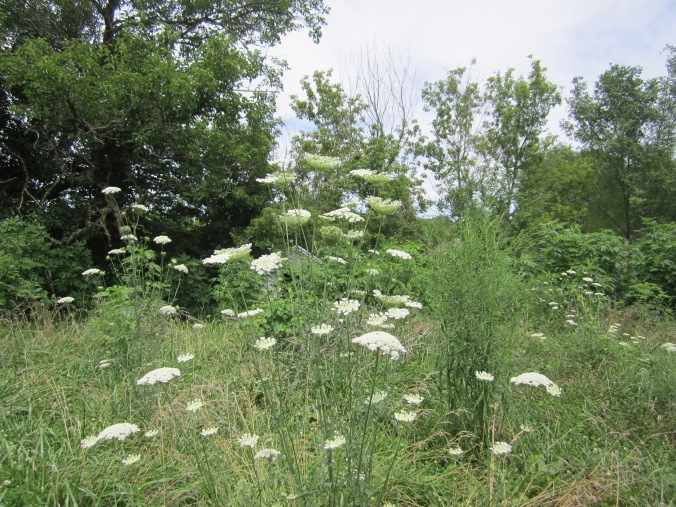As most of you already know, I have been taking WordPress’s Blogging 101 class. Yesterday’s assignment involved looking up the daily writing prompt and using it to write a blog post. The prompt had to do with being deceived by someone.
One might think that the art of deception is limited to human beings, but it isn’t. The natural world is full of deception too. I’m not going to go into my beliefs about how the earth is cursed because of Adam and Eve’s sin in the garden, I”m just going to discuss some interesting ways that nature can be deceptive. Knowing many of them could save your life.
One of the most common deceptions is camouflage. Think of the chameleon that changes colors to match it’s environment, thereby protecting itself from predators. Many species of butterfly have markings that make them appear to be something else entirely. That “log” in the river just might be a crocodile.
Plants are deceptive too. Think of the Venus fly trap. When you start foraging and learning about wild edibles, and edible plants in general, it is extremely important to understand that not all berries are edible, no matter how tasty they look. Pretty is no guarantee for safety. Unless you absolutely know the identity of that plant; don’t eat it! When in doubt, leave it out!
Elderberries and mulberries are wonderful edible berries. Choke and pin cherries are edible, but you probably won’t want many of them. Poke berries will kill you. When in doubt, leave it out. I have everything on my property except Elderberries. I just may have to plant some.
Several wild edible plants have poisonous lookalikes. Wild Carrot, aka Queen Anne’s Lace, is edible. One lookalike is the wonderful medicinal plant, Yarrow. A second lookalike, Poison Hemlock, will kill you. To tell the truth, once you know for sure the differences between these plants, you won’t mix them up, but for a novice forager, the similarities are confusing. When in doubt, leave it out! I would love to find some yarrow on our property, but again, I will probably plant some next spring.
It’s a good idea to get a book, or books, on the wild edibles located in your area. I have a little book called Edible Wild Plants: A North American Field Guide To Over 200 Natural Foods. It’s available on Amazon here. (This is not an affiliate link). What I like about this book is that it lists poisonous lookalikes. The internet is a good source too. I belong to a facebook page that is devoted to wild edibles in Missouri. I am constantly impressed with the knowledge in that group. I bet you have one close to you too.
If you’re like me, and really need to see it, youtube videos, like this one, can be a great source as well. However you choose to find your information, I cannot stress enough the importance of knowing what you are eating BEFORE you eat it. Don’t be deceived. When in doubt, leave it out!
Connie




Wow, I love your post and blog. You are such a good writer, I really enjoy this blog.
LikeLike
Thank you!
LikeLike
Thanks for taking time to look at my blog. It’s interesting, here in the UK elder is a weed in my garden. My mum used to make me drink elderflower tea when I had a cold – it tasting like cat’s wee and my cold always seemed to be ten times worse after. But the elderberry port my brother made was something else. He was very stingey at giving it away though.
LikeLiked by 1 person
I bet he was! Over here they make elderberry jam too, as well as a syrup for coughs.
LikeLike
I have several beautiful plants I can’t identify, so stay clear of them. I do have yarrow and queen Anne’s lace, although haven’t got around to using them lately. Your post is a smart reminder to people like me to take great care in the garden.
LikeLike
Yeah, if you don’t know what it is, leave it alone. I grew yarrow at our last place and dried it. I still have a little left. It is the absolute best for stopping bleeding.
LikeLike
I must assume, from this post, that you grow your own medicinal herbs?
LikeLike
I am just starting to do that. Most of what I have for medicinals now are things that grow wild, like plantain and mullein.
LikeLiked by 1 person
I find this fascinating. Thank you for sharing! The next time I am suffering from an ailment I might just ask you what you suggest..😉 And thank you for including the links, I might add that book to my library.
LikeLike
Thanks! The book is great. It also tells you when to harvest and how to prepare each plant.
LikeLiked by 1 person
Thanks for writing such an informative post. I’m always amazed at the variations that abound in nature…and the way you began, with the concept of deception – it anchored my attention to the piece.
LikeLiked by 1 person
Thank you so much!
LikeLiked by 1 person